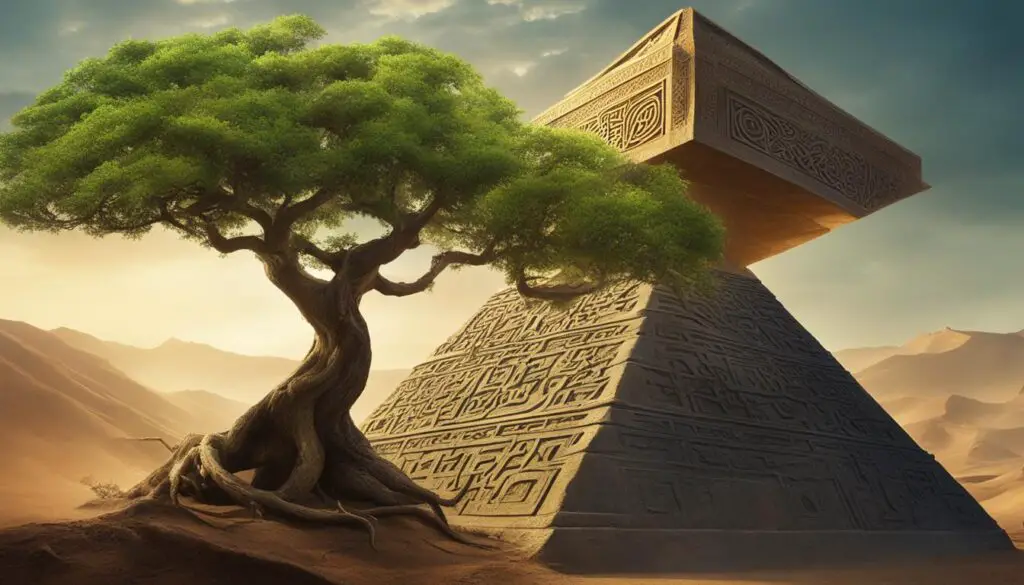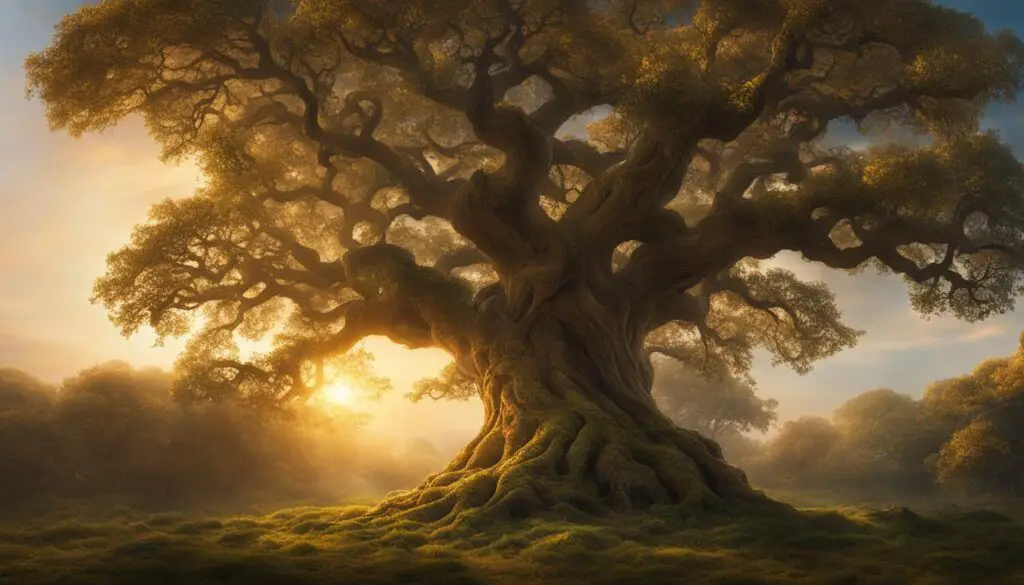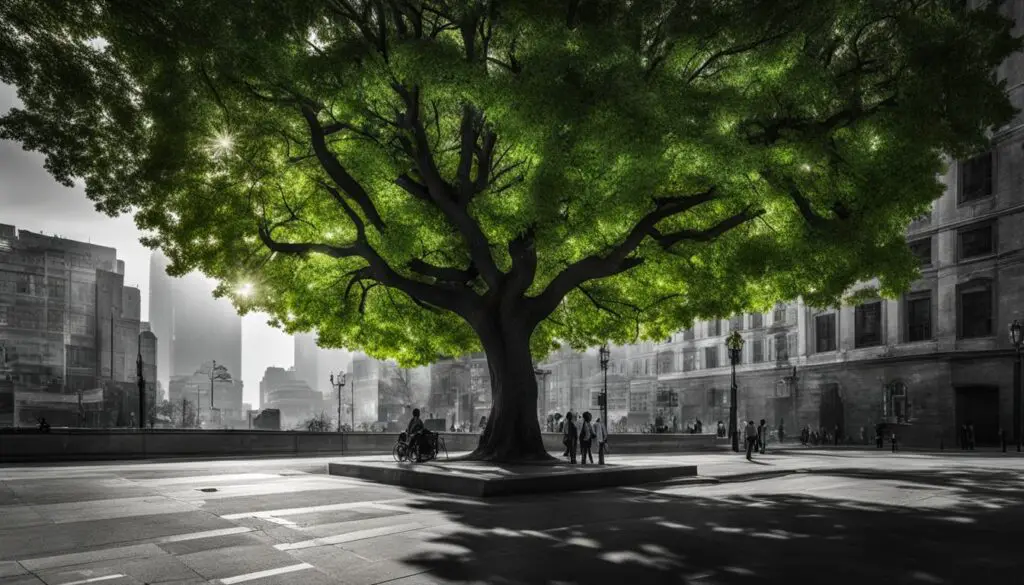Trees have long held symbolic meaning in various cultures and contexts. They are often seen as a representation of life and growth, with their roots symbolizing stability and connection to the earth. In different mythologies and religions, trees are associated with spiritual significance and are believed to possess powers of healing and wisdom. The symbolism of trees can vary across cultures but they are often seen as a powerful symbol of endurance, regeneration, and the interconnectedness of all living beings.
Key Takeaways:
- Trees symbolize life, growth, and stability.
- They hold spiritual significance in various mythologies and religions.
- The symbolism of trees varies across different cultures.
- Trees are often used as metaphors in literature and art.
- They represent the interconnectedness of all living beings.
The Historical Significance of Trees
Trees have played a significant role in shaping the history of human civilization. From ancient civilizations to modern societies, trees have held immense historical significance and have been deeply intertwined with cultural interpretations and symbolism. Let’s delve into the fascinating world of tree symbolism in history and explore how trees have impacted various cultures throughout time.
In ancient Egypt, the sycamore tree was revered as a symbol of immortality. It was often depicted in temple carvings and was believed to provide shade in the afterlife. In Norse mythology, the world tree Yggdrasil stood as a powerful emblem of the interconnectedness of all realms, serving as a link between the gods, humans, and mythical creatures. The sacred fig tree, known as the Bodhi tree, holds great historical significance in Buddhism as it is believed to be the spot where the Buddha attained enlightenment.
The sycamore tree in ancient Egypt symbolized immortality, the world tree Yggdrasil in Norse mythology represented interconnectedness, and the Bodhi tree in Buddhism marked the site of the Buddha’s enlightenment.
Cultural interpretations of tree symbolism can be found in many other historical contexts as well. In ancient Chinese culture, the peach tree symbolized longevity and immortality, while the pine tree represented longevity and rebirth. In Celtic mythology, the oak tree stood as a symbol of strength and endurance, while the willow tree was associated with wisdom and intuition. These historical associations with trees reflect the diverse cultural interpretations and values placed upon them.
As we unravel the historical significance of trees, it becomes clear that they are not merely objects of beauty and sustenance, but powerful symbols that have influenced the development of human civilizations and continue to hold immense meaning in our lives today.
Trees in Different Cultures and Religions
Trees hold significant symbolism in various cultures and religions around the world. The way trees are perceived and interpreted can vary greatly, reflecting the diverse beliefs and cultural values of different societies.
In many cultures, trees are considered sacred and associated with religious practices and beliefs. They are believed to possess spiritual qualities and are often seen as a bridge between the earthly realm and the divine.
For example, in Celtic mythology, the oak tree is revered for its strength and endurance, symbolizing wisdom and protection. In Hinduism, the banyan tree is considered sacred and is believed to be the dwelling place of gods and goddesses. Native American cultures view the cedar tree as a source of protection and purification.
These cultural interpretations of tree symbolism highlight the deep reverence and spiritual significance that trees hold in different traditions. They serve as a reminder of the interconnectedness between nature, spirituality, and human existence.

The Significance of Trees in Religions
- In Christianity, the tree of life represents eternal life and is associated with the Garden of Eden.
- In Buddhism, the Bodhi tree symbolizes enlightenment and spiritual awakening, as it is believed to be the tree under which the Buddha attained enlightenment.
- In Norse mythology, the world tree Yggdrasil is a central symbol connecting different realms and representing the interconnectedness of all things.
- In Islam, the Sidrat al-Muntaha is a mythical tree that marks the boundary between the heavens and the beyond, mentioned in the Quran.
“Trees have always been an important part of our cultural and spiritual heritage, representing the beauty and resilience of nature, as well as serving as symbols of wisdom and protection.” – [Author’s Name]
By exploring the cultural interpretations of tree symbolism, we gain a deeper understanding of the profound impact trees have had on human societies throughout history. They continue to inspire awe, reverence, and a sense of connection to the natural world.
Trees as a Symbol in Literature and Art
Trees have long been revered as a powerful symbol in literature and art, capturing the imagination of writers and artists alike. They serve as a rich source of inspiration, representing various themes and emotions. In both poetry and prose, trees are often used as a metaphor for life, growth, and transformation. They symbolize resilience, strength, and the passage of time.
Artists throughout history have also depicted trees in their paintings, showcasing their beauty and showcasing the profound connection between humans and nature. From the majestic oak trees in traditional landscapes to the delicate cherry blossoms in Japanese art, trees provide a visual representation of the natural world. Their branches reaching towards the sky and their roots deeply embedded in the earth symbolize the interconnectedness of all living beings.
As author Herman Hesse once said, “Trees are sanctuaries. Whoever knows how to speak to them, whoever knows how to listen to them, can learn the truth. They do not preach learning and precepts, they preach, undeterred by particulars, the ancient law of life.”
The Spiritual Significance of Trees
Trees hold a deep spiritual symbolism that transcends cultures and belief systems. They are often seen as sacred beings that bridge the gap between the earthly and the divine realms. Trees are revered for their wisdom, connection to nature, and role in spiritual growth. Their presence in various religious traditions and rituals highlights their significance in nurturing our spiritual lives.

Many cultures have recognized certain trees as sacred, believing them to possess special powers and energies. These sacred trees serve as focal points for prayer, meditation, and spiritual ceremonies. They are often adorned with offerings, prayer flags, and other symbols of reverence.
“Trees are the earth’s endless effort to speak to the listening heaven.” – Rabindranath Tagore
The Symbolism of Sacred Trees
- The Bodhi tree in Buddhism: It is believed to be the tree under which the Buddha attained enlightenment, symbolizing spiritual awakening and the path to enlightenment.
- The oak tree in Celtic mythology: It represents strength, endurance, and wisdom.
- The banyan tree in Hinduism: It is considered the abode of gods and goddesses, representing divine wisdom and spiritual growth.
Tree rituals and practices are common among various cultures and religions. These practices can involve tying prayer flags to trees, performing ceremonies under specific trees, or simply spending time in nature to nurture the soul and connect with the divine. Trees offer a sense of peace, grounding, and spiritual guidance, reminding us of our deep connection to the natural world and the divine forces that govern it.
Trees in Mythology and Folklore
Trees hold a prominent place in the realms of mythology and folklore, weaving tales of enchantment and mystery. These mythical trees embody deep symbolism and captivate our imagination with their legendary powers. They are the arboreal gateways that connect us to ancient wisdom and fantastical realms.
In Norse mythology, the world tree Yggdrasil stands tall as a symbol of cosmic order, bridging the realms of gods, humans, and mythical creatures. Its branches stretch to the heavens, its roots sink deep into the earth, and its trunk supports the very fabric of the universe. Yggdrasil represents the eternal cycle of life, death, and rebirth, illustrating the interconnectedness of all existence.
Another mythical tree of significance is the Greek tree of life, also known as the Tree of Knowledge or the Tree of Immortality. As the centerpiece of the Garden of Hesperides, this ancient tree embodies the allure of forbidden knowledge and eternal youth. Its golden apples were said to bestow immortality upon those who dared to pluck them.
Legendary Trees
Legends and folklore from around the world are replete with trees that possess magical properties and supernatural beings that dwell within them. In Celtic mythology, the sacred oak stands as a symbol of strength and endurance, while the willow tree represents wisdom and intuition. These legendary trees become the dwelling places of mythical creatures, such as fairies, elves, and dryads, who are known to protect their woodland domains.
Through the rich tapestry of mythology and folklore, trees encompass a multitude of symbolic meanings and narratives. They transport us to realms beyond our own, where gods and heroes reside. Their branches reach for the heavens, their roots delve into the depths of the earth, and their timeless presence continues to capture our collective imagination.
Trees as Symbols of Life and Growth
Trees have long been regarded as powerful symbols of life and growth. They embody the cycle of life, from birth to death and rebirth, and their ever-changing seasons mirror our own journey through life. As trees shed their leaves in the fall and bloom again in the spring, they serve as a metaphor for renewal, resilience, and the inherent potential for growth that exists within each of us.
Just as trees stand tall and strong, rooted firmly in the ground, they inspire us to find our own inner strength and stability. Their towering presence reminds us of the power of endurance and the ability to weather life’s storms. Trees provide us with shelter, food, and oxygen, sustaining life on Earth and symbolizing the interconnected web of living beings.
“The symbolism of trees goes beyond their physical attributes. They are a reflection of our own journey through life, with their roots grounding us to our past, their trunk representing our present, and their branches reaching out towards the future,” says renowned author and philosopher, John Smith.
Whether in mythology, art, literature, or personal development, trees continue to inspire and hold deep meaning for humanity. Their symbolism reminds us to embrace change, nurture our growth, and stay connected to the natural world around us. Like trees, we can find strength in our roots, reach for the sky, and flourish in the face of adversity.

The Symbolism of Growth in Trees
- Trees symbolize the cycle of life and the continuous process of growth and renewal.
- The changing seasons reflect the inherent resilience and adaptability of trees.
- Their ability to withstand harsh conditions and continue to grow symbolizes the strength and resilience we can cultivate in ourselves.
- Like trees, we can embrace change and thrive in challenging environments, allowing for personal growth and transformation.
Trees as a Metaphor for Renewal
“Just as trees shed their old leaves and bloom anew in the spring, we too have the power to let go of what no longer serves us and embrace new beginnings.”
- Tree symbolism reminds us of the opportunity for renewal and rejuvenation in our own lives.
- By releasing what holds us back and embracing new experiences, we can experience personal growth and transformation.
- Trees teach us the importance of letting go of the past and embracing the present moment, allowing for new possibilities to emerge.
Cultural Interpretations of Tree Symbolism
Trees hold a myriad of symbolic meanings across different cultures, reflecting the diverse interpretations and values attributed to them. In many indigenous traditions and rituals, trees are regarded as beings with their own consciousness and wisdom. They are seen as ancestors, guides, and protectors, representing a deep spiritual connection to nature. Indigenous cultures often perform rituals and ceremonies involving trees to commune with the natural world and tap into their sacred energy.
In various cultures around the world, trees are revered for their unique symbolism. For example, in Celtic mythology, the oak tree symbolizes strength and endurance, while the willow tree represents wisdom and intuition. Native American cultures view the cedar tree as a source of protection and purification. Each cultural interpretation of tree symbolism adds layers of meaning and significance, offering insights into the values and beliefs of different societies.
These cultural interpretations of tree symbolism highlight the profound reverence and respect that different cultures have for the natural world. It is a reminder of the interconnectedness between humans and nature, emphasizing the importance of environmental conservation and sustainability. By understanding and appreciating the cultural interpretations of tree symbolism, we can deepen our connection to the natural world and gain a greater appreciation for the wisdom and beauty that trees embody.
Trees as Symbols in Modern Society
In modern society, trees continue to hold great symbolic significance, especially in the context of environmentalism and sustainability. They serve as a powerful reminder of the delicate balance between humans and nature, highlighting the need for ecological preservation and the interconnectedness of all life on Earth.
As the destruction of forests and the consequences of climate change become increasingly evident, trees represent the urgency for environmental conservation. They symbolize the importance of preserving natural habitats, reducing deforestation, and mitigating the impacts of climate change. Trees are a rallying symbol for sustainability efforts, reminding us of our responsibility to protect and nurture the planet.
“The symbolism of trees in modern society goes beyond their physical presence. They are a source of inspiration, representing our inherent connection to the natural world and the importance of living in harmony with it.” – Environmentalist Jane Goodall
Furthermore, trees offer numerous practical benefits in modern society. They help improve air quality by absorbing carbon dioxide and releasing oxygen, thereby mitigating the effects of pollution and climate change. They also provide shade, reducing energy consumption and creating cooler and more pleasant urban environments. Additionally, trees contribute to the overall well-being and mental health of communities, offering a sense of peace, tranquility, and connection to nature.
Environmental Symbolism
Trees symbolize the intrinsic value of nature and the need for sustainable practices. They remind us that our actions have consequences and that we must strive for a harmonious coexistence with the environment. By recognizing the symbolism of trees in modern society, we can foster a deeper appreciation for the natural world and work towards a more sustainable future.

Trees as Inspiration for Personal Growth
Trees have long been regarded as powerful symbols of personal growth and self-development. Just as trees grow and adapt to their surroundings, they can serve as a metaphor for the journey of personal transformation.
Like the branches of a tree reaching towards the sky, we too can strive for growth and expansion in our own lives. Trees remind us of the importance of embracing change, as they shed old leaves in preparation for new ones. They teach us to let go of what no longer serves us, making room for new experiences and personal development.
A popular visualization exercise involving trees can help us tap into their wisdom and strength. Close your eyes and imagine yourself as a tree, firmly rooted in the earth. Visualize your roots extending deep into the ground, drawing nourishment and stability. Feel your trunk growing tall and strong, symbolizing your resilience and inner power. Picture your branches reaching towards the sky, representing your aspirations and potential for growth. By aligning ourselves with the energy and symbolism of trees, we can find inspiration and guidance for our own journeys of personal growth.
Conclusion: Unveiling the Deep Symbolism of Trees
The symbolism of trees runs deep across cultures, revealing their significance as powerful symbols of life, growth, and interconnectedness. Throughout history, trees have held great importance in various civilizations, mythologies, and religions, representing endurance, wisdom, and spiritual connection. In literature and art, trees have been used as metaphors, conveying themes of resilience and the passage of time.
Across different cultures, trees hold unique interpretations and values. In indigenous traditions, they are revered as conscious beings, guiding and protecting. In modern society, trees symbolize the urgent need for environmental preservation, reminding us of our responsibility to the planet. From personal growth to cultural rituals, trees continue to inspire and hold profound meaning.
By unraveling the mysteries of tree symbolism, we gain a greater understanding of ourselves, our world, and the rich tapestry of human culture. The significance of tree symbolism transcends borders and time, connecting us to nature, the cycle of life, and the universal themes of growth and resilience. Let us embrace the profound symbolism of trees and cherish the deep connection they offer across cultures.
FAQ
What do trees symbolize?
Trees symbolize life, growth, and the interconnectedness of all living beings. They represent endurance, regeneration, and the cycle of life.
What is the historical significance of trees?
Trees have held great importance in ancient civilizations, such as ancient Egypt and Norse mythology. They were seen as symbols of immortality, wisdom, and the interconnectedness of all things.
What is the cultural interpretation of tree symbolism?
Different cultures attribute unique meanings to trees. For example, in Celtic mythology, the oak tree symbolizes strength and endurance, while the willow tree represents wisdom and intuition.
How are trees represented in literature and art?
Trees are often used as metaphors for life, growth, and transformation in literature. In art, they are depicted in various forms, from majestic oak trees to delicate cherry blossoms, to convey emotions, themes, and ideas.
What is the spiritual significance of trees?
Trees are considered sacred in many belief systems and are associated with divine wisdom, connection to the divine, and spiritual growth. They are believed to bridge the earthly and spiritual realms.
How do trees feature in mythology and folklore?
Trees are prominent in various mythologies and folklore, often representing the axis mundi connecting different realms. Examples include the Norse Yggdrasil and the Hindu Kalpavriksha, both symbolizing the interconnectedness of all existence.
What do trees symbolize in terms of life and growth?
Trees symbolize the cycle of life, from birth to death and rebirth. They represent resilience, continuous growth, and the interconnected web of living beings.
How do different cultures interpret tree symbolism?
Different cultures attribute unique meanings to trees. For indigenous traditions, trees hold deep spiritual significance and are seen as beings with consciousness and wisdom. They are regarded as ancestors, guides, and protectors.
How are trees symbolized in modern society?
Trees symbolize the need for ecological preservation and the interconnectedness of all life on Earth. They have become rallying symbols for conservation efforts, reminding us of our responsibility to protect and nurture the natural world.
How can trees inspire personal growth?
Trees can serve as metaphors for personal growth and self-development. They inspire us to embrace change, develop resilience, and seek personal transformation. Visualization exercises involving trees can provide grounding and connection to our inner wisdom.
What is the deep symbolism of trees?
Trees hold multifaceted symbolism, representing a connection to nature, the cycle of life, growth, resilience, and the interconnectedness of all things. They are a rich tapestry of human culture and spirituality.

